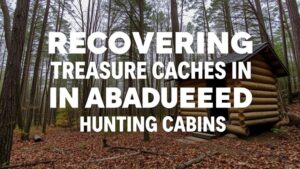Unearthing Lost Relics in Wilderness Cabins and Campsites
Unearthing Lost Relics in Wilderness Cabins and Campsites
The wilderness has long been a refuge for individuals seeking solitude, adventure, and a connection to nature. But, many cabins and campsites hold stories and artifacts that reveal the regions historical and cultural significance. Unearthing these relics not only fosters a deeper appreciation for our heritage but also evokes curiosity regarding the lives and traditions of those who once occupied these spaces. This article delves into the methodologies, ethical considerations, and potential findings involved in exploring these often-forgotten locales.
Understanding the Historical Context
To properly excavate and appreciate lost relics, one must first grasp the historical context of wilderness cabins and campsites. These structures often date back to the 19th and early 20th centuries when camping became popularized as a leisure activity. For example, the Adirondack cabins constructed during the 1800s symbolize a shift towards tourism and outdoor recreation, while also serving as seasonal residences for wealthy individuals.
Historic maps and local histories can provide valuable insights into former occupants and their lifestyles. Knowledge about local indigenous tribes can also inform the understanding of how the land was used and valued before European settlers arrived. This thorough background understanding is crucial for archaeologists and urban explorers alike who seek to find and interpret lost artifacts.
Methodologies for Unearthing Relics
Exploring and excavating wilderness cabins and campsites require specialized techniques and methodologies to maximize the potential for discovering valuable artifacts. Some primary methods include:
- Ground Penetrating Radar (GPR): This non-invasive technique helps locate structures or objects beneath the surface. GPR uses radar pulses to create images of the subsurface, making it an excellent tool for identifying buried remnants without disturbing the site.
- Test Excavation: Small, controlled excavations are conducted in promising locations to evaluate the potential for relics. This practice helps researchers form hypotheses on site usage while minimizing damage.
- Remote Sensing: Utilizing aerial photography or satellite imagery can identify larger patterns, such as pathways or clusters of buildings that could indicate human activity in the past.
These methodologies must be applied methodically to record all findings accurately and preserve the integrity of the site for future study.
Ethical Considerations
Diligence regarding legal and ethical considerations cannot be overstated when it comes to unearthing relics. Compliance with archaeological guidelines and local regulations is crucial. For example, many states require permits for excavation on public land. Failing to adhere to these laws could result in fines or prosecution.
Also, respect for the cultural significance of findings, especially those related to indigenous peoples, should guide the excavation process. Efforts must be made to engage with local communities, seeking their insight and encouraging collaborative efforts to preserve their heritage. This ethical stance not only fosters community relationships but enhances the integrity of the research conducted.
Potential Relics and Their Significance
The discovery of artifacts within wilderness cabins and campsites can yield significant insights into the lives of past occupants. Common findings include:
- Tools: Items such as axes, knives, and cooking utensils often reveal much about the daily life and survival strategies of previous occupants.
- Personal Items: Objects like buttons, coins, or old photographs provide a personal glimpse into the identities and lifestyles of individuals who once frequented these sites.
- Building Materials: Remnants of construction methods and materials can inform researchers about the technologies and resources available during different historical periods.
For example, a recent excavation at an abandoned cabin in Michigan revealed a tool cache consisting of hand-forged tools, indicative of early 20th-century craftsmanship. Such findings allow historians and archaeologists to piece together the narrative of human settlement patterns and economic activities in the region.
Case Studies of Forgotten Campsites
Several notable case studies exemplify the treasure trove of information that can emerge from successful excavations. One prominent example is the Great Basin National Parks historic cabins, where an archaeology team uncovered items such as clothing scraps and cooking implements–each piece shedding light on the areas mining history.
Another significant project was conducted in the Allegheny National Forest, where a long-abandoned campsite revealed a trove of personal artifacts that had remained undisturbed for decades. Analysis of these objects has led to enhanced community programs that focus on preserving not only relics but also the stories they tell.
Conclusion: The Future of Relic Exploration
Unearthing lost relics in wilderness cabins and campsites presents a unique opportunity to engage with history and honor our past. By employing careful methodologies, adhering to ethical standards, and appreciating the stories told by these artifacts, we can forge a deeper connection with our cultural landscape.
As technology continues to advance, the potential for discovering lost relics will only grow. Educational programs and community partnerships will play a pivotal role in ensuring these explorations are responsible and beneficial to society at large. Ultimately, the relics we uncover serve not just as remnants of the past but as catalysts to inspire future generations to preserve and appreciate the narrative of our shared history.



